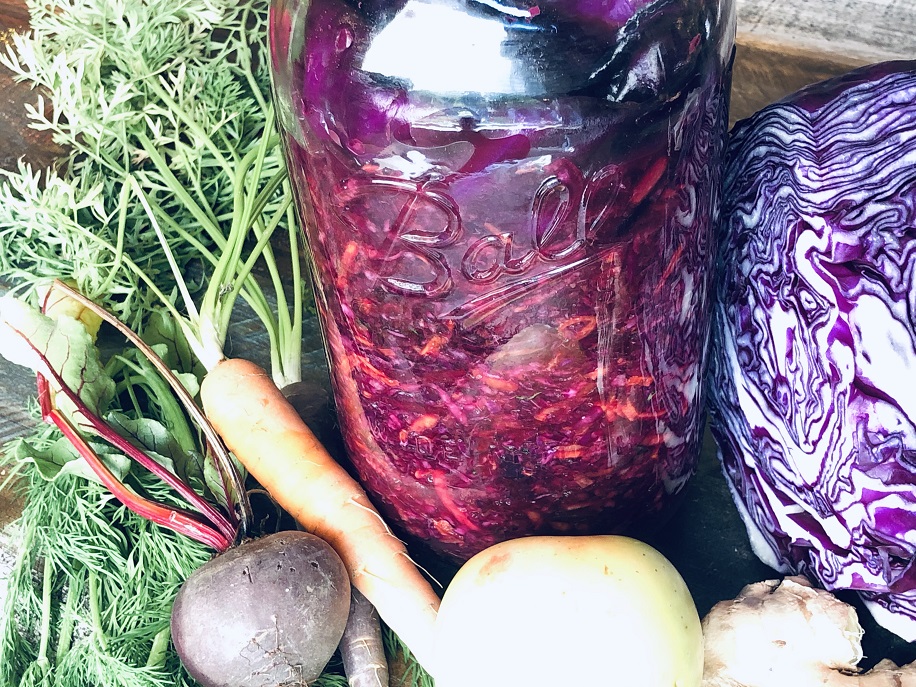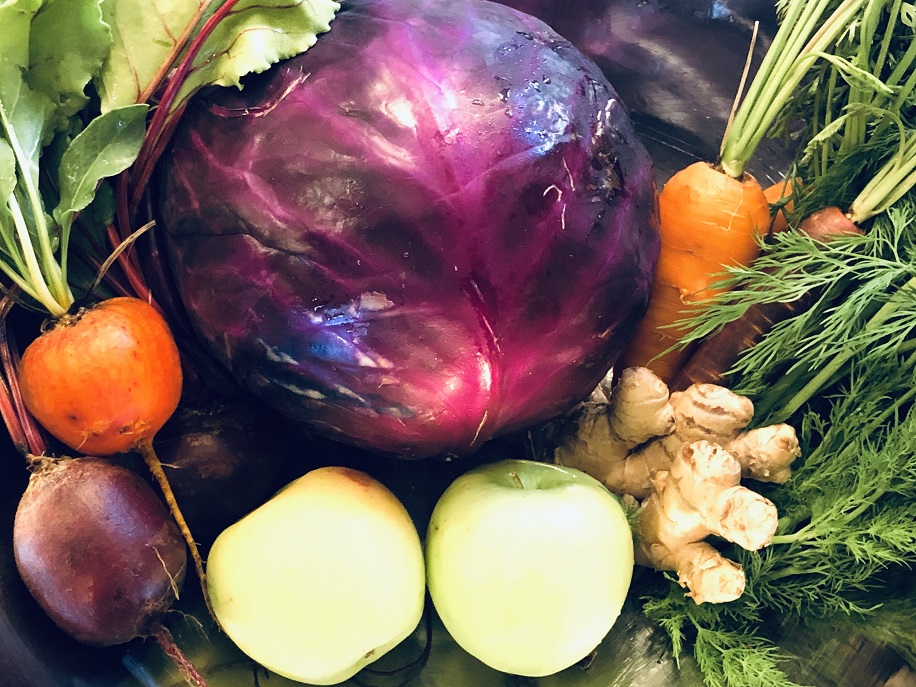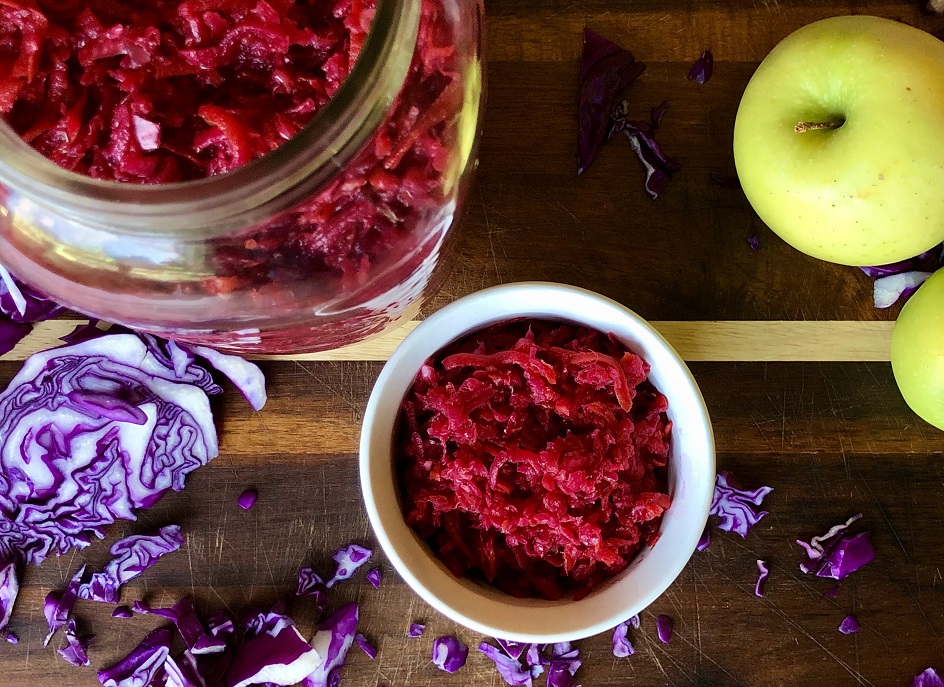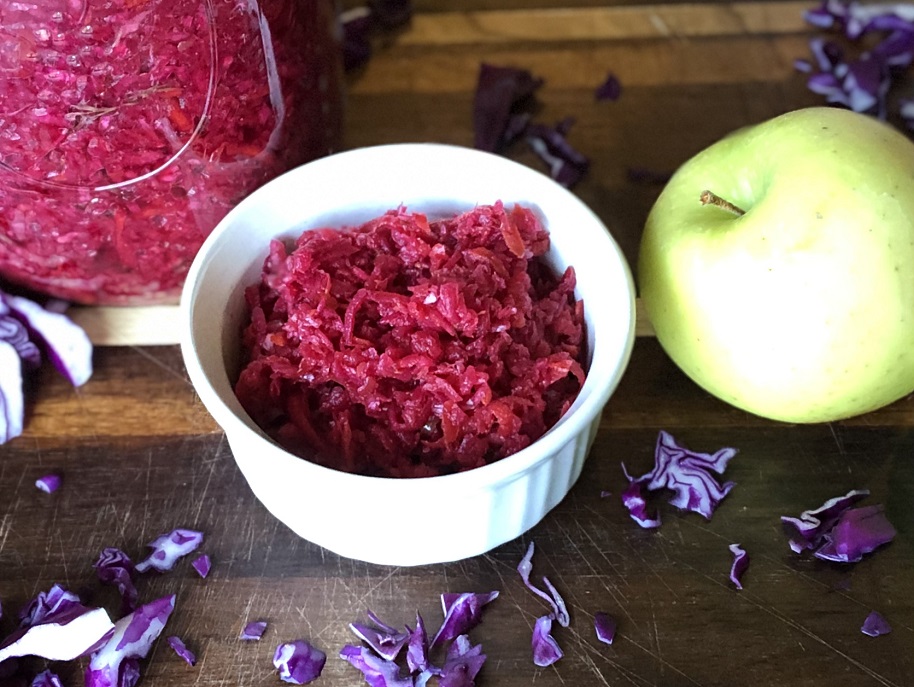Amazing Fermented Red Cabbage Sauerkraut with Beet, Ginger, and Apple

Amazing Fermented Red Cabbage Sauerkraut with Beet, Ginger, and Apple is a sauerkraut recipe you won’t want to miss! Not only are the colors amazing, but it tastes amazing too! I couldn’t believe how beautiful and bright the mixture of veggies was after they were all shredded and mixed together.
We had the red cabbage, red and golden beets, orange and purple carrots, and the green apple all working together and providing us with their color and nourishment vibes. This along with added ginger, dill, turmeric, salt, and a touch of black pepper give this sauerkraut a deliciously tangy and tart flavor with a hint of spice.
This recipe is so versatile. Many different vegetables and seasonings can be used. Try adding turnip, radish, kohlrabi, onion, garlic, fennel, peppers, red pepper flakes, coriander seeds, caraway seeds, or juniper berries. The possibilities are endless.
Fermentation is the exhalation of a substance through the admixture of a ferment which, by virtue of its spirit, penetrates the mass and transforms it into its own nature.
Andreas Libavius
Table of Contents
FERMENTED VEGETABLE BENEFITS (1)
- Supports digestive health by increasing the good bacteria in the gut microbiome
- Boosts the immune system
- Supports brain health
- Fermented foods are easier to digest
- Helps release vitamins and minerals from the vegetables thus allowing our bodies to better absorb and use them

AMAZING FERMENTED RED CABBAGE SAUERKRAUT WITH BEET, GINGER AND APPLE RECIPE TIPS
- This recipe will fill close to one 64 oz or two 32 oz mason jars. Or you can use a fermentation jar such as the Mortier Pilon glass fermentation jar. This was given to us as a gift and we love it. It comes with a ceramic fermentation weight, a wax pencil for labeling, and an instruction/recipe book. It was being used when I made the above video, so we used the mason jars for this batch.
- Use good quality organic vegetables and ingredients.
- Be sure to add a pinch of pepper when cooking or preparing foods with turmeric. You will not receive health benefits by taking curcumin on its own, as the body does not properly absorb it. When curcumin is taken with pepper, bioavailability is increased by 2,000%. (2)
- Allow the vegetables to ferment at room temperature (approx 70 degrees) out of direct sunlight for 7-10 days or to taste.
- Use a fermentation weight, heavy rocks in a ziplock bag or cabbage leaves layered on top to keep veggies submerged in the brine.
- Be sure to take the lid off once a day to release any carbon dioxide pressure that has built up in the jar.
- It is a good idea to label your jars with the date you processed the vegetables.
- Check the top of the jar every day or two to make sure all of the vegetables are still submerged in the brine.
- Taste test your sauerkraut and refrigerate it with a tight-fitting mason jar lid after it is fermented to your liking.
- If you notice a thin layer of film or surface mold, scrape and remove that layer. The vegetables should be fine so long as they are fully submerged in the brine.
- Fermented vegetables can last 6 months up to 1 year if refrigerated. (2)


Amazing Fermented Red Cabbage Sauerkraut with Beet, Ginger and Apple
Ingredients
Equipment
Method
- Peel the first 2-3 outer leaves from the cabbage and reserve for later. Cut the cabbage in half and remove the core.
- Using a food processor, grater, or a sharp knife, shred (or cut into thin small pieces) ½ f of the red cabbage, 4 carrots, 3 beets, 1 apple, and the knob of ginger. This will result in approx 3 pounds of mixed shredded vegetables.
- In a large bowl, mix all of the shredded vegetables with a spoon and add 1 tbsp of the sea salt.
- Allow the salt and vegetable mixture to sit for about 5 minutes.
- Using your hands, massage the veggies for around 5 minutes until you are able to naturally withdraw a good amount of liquid from the vegetables when you squeeze them. **See the video above.
- Add ½ tablespoon salt, 1 tsp turmeric, and ⅛ tsp pepper.
- Mix well and continue to massage vegetables a few minutes longer.
- Fill the fermentation jar or mason jar with the cabbage mixture. Leaving ½ inch of headspace at the top.
- Press the vegetables firmly down into the jar until everything is submerged under the brine.
- Add the reserved cabbage leaves as a top layer of the sauerkraut to keep the vegetables submerged or use the fermentation weight.
- Cover the jar with the mason jar lid.
- Label the jar with the processing date.
- Allow the vegetable mixture to ferment at room temperature (approx 70 degrees) for around 7-10 days or to taste.
- Be sure to take the lid off once a day to release any carbon dioxide pressure that has built up in the jar.
- Refrigerate when fermentation is complete.
- Enjoy!
Notes
Fermentation may have been a better invention than fire.
David Wallace

Looking to ferment your pickles? Check out our Best Fermented Dill Pickles – Summer Garden Recipe. And for more healthy recipes, visit our recipes page here.


I eat something fermented every day for the health benefits. I decided to try homemade sauerkraut, because that’s my favorite fermented food. I bought a small fermentation crock and labeled the jar like you suggested with the date. I was so nervous when it was revealed day. This sauerkraut is amazing! The fresh ginger really brought out the other flavors, and it is absolutely beautiful! So many health benefits and deliciousness in this recipe. Thank you for sharing!
PS: Don’t forget the black pepper. It’s necessary to increase the benefits of the turmeric!
This makes me so happy! Thank you for your comment. I am so glad you enjoyed it!
My red cabbages can be any size, what is the weight needed for this recipe?
I do not know the weight needed for the recipe. I will weigh it when I make my next batch and provide the update. I used half of a large head of cabbage along with the other vegetables. Once mixed with the salt, it filled almost a 64oz jar before I pressed it into the brine. I hope that helps for now. You can see it in the video as well.
Great recipe and intro to fermenting for me!!! Thank you!
Thank you for your comment. I hope you are able to give it a try! I really enjoy homemade sauerkraut and it has such great health benefits.